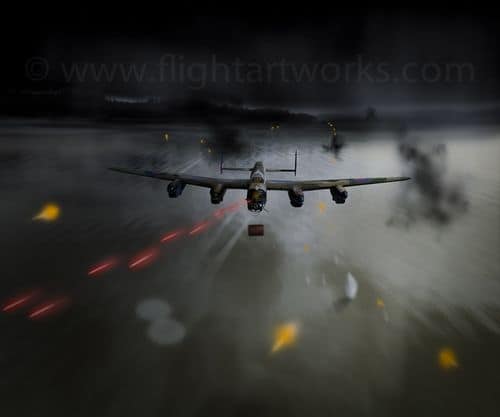
High Wycombe, 1 Feb 2013
Seeing this picture in my Dambusters series several people queried – or challenged – the fact that I have the lights pointing off to the right of the aircraft.
So I thought it was worth explaining this. It does not help that a number of aviation artists have in the past got this wrong, typically showing the lights either pointing straight down or off at an impossible angle when the aircraft are banked so as to remain pointing down. Both wrong.
If you have seen the celebrated Michael Anderson film made in the 1950s about The Dam BustersTM you will know that clever old Guy Gibson was not only a wonderful team leader, pilot and dog owner but also a part-time engineering genius who cracked the problem of how to fly a Lancaster bomber at a consistent 60ft over water at night when no altimeter was accurate enough to measure this.
Visiting a London theatre our hero notices how the two spotlights illuminating the star of a dance number track her to and fro across the stage at a precise distance from the front. Eureka.
This might not be complete tosh in that I think I read somewhere that some of the aircrew claimed they had remarked on just this phenomenon.
Angles
But the solution for 617 Squadron‘s special Lancaster bombers in reality is down to a man who must have been paying attention in geometry lessons at Manchester Grammar School: George Pickard, who in 1938 was posted to the Royal Aircraft Establishment, Farnborough. He designed a simple altimeter using two spotlight beams to help Coastal Command aircraft fly low at night to attack submarines. The device was recalled by Ben (later Sir Benjamin) Lockspeiser at the Ministry of Aircraft Production and applied to the Lancasters.
There is a formula for positioning two Aldis lamps on a Type 464 (Provisioning) Lancaster along the lines of d1 = [(h1 + 1 in) x tan 30° -0.7in] feet … and so on.
The upshot is that you have one in the front camera housing under the aircraft’s nose angled 30° to the right and another at the back of the bomb bay angled 40° to the right but also forwards, in such a way that their beams form two adjacent circles in a sort of figure-of-eight arrangement out under the starboard wing at 60ft below.
This can be monitored by the navigator (but certainly not the pilot or the bomb aimer, who are rather busy) who then calls out, “Up a bit, down a bit … “. When the aircraft is too high, the rear spotlight’s pool of light moves forwards and when it is too low it moves back.
There is a small general arrangement drawing on the RAF Museum website. I would direct you to a better, scaled diagram as well except that I think my own picture above gets it just right so far as I can tell. A two-page explanation with graphics can be found in, of all places, the Haynes manual for the Dambusters’ Lanc. – part of that series of theirs which, worryingly, does also include the Star Wars freighter Millennium Falcon and the Star Trek flagship Enterprise.
I digress. Maybe not though. The other big challenge in this latest picture was: what do tracer bullets look like? I think I will save that for another time.
—————————
To buy prints of any of my works please visit www.flightartworks.com.
Publishers’ enquiries are also welcome: many images are available already to license through the Alamy agency.
To get in touch visit the Contact page on my website. Find Flight Artworks on Facebook, and on Twitter @flightartworks.
May I ask, was it necessary to ‘merge’ the two lights, so they appeared as one, at 60 feet, or were they to be kept adjacent, as shown above? So has the aircraft begun to lift, after the release of the mine, which is why the lights appear separately, or are they in fact ‘correct for 60feet’ and the pilot is keeping the aircraft level?
Sorry, just interested to know how they appeared when ‘correct for 60 feet’.
As the article explains, “their beams form two adjacent circles in a sort of figure-of-eight arrangement out under the starboard wing at 60ft below”. I think there is a question of 60ft below what? – wing, cockpit, weapon, etc – and I am not sure anyone now knows this.